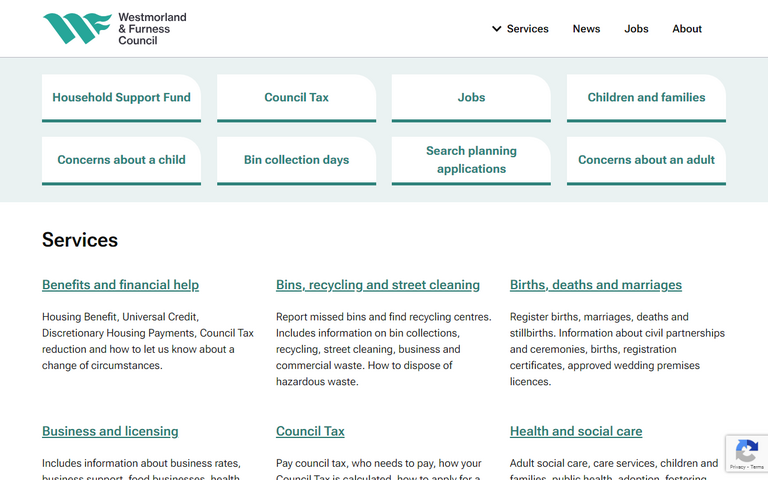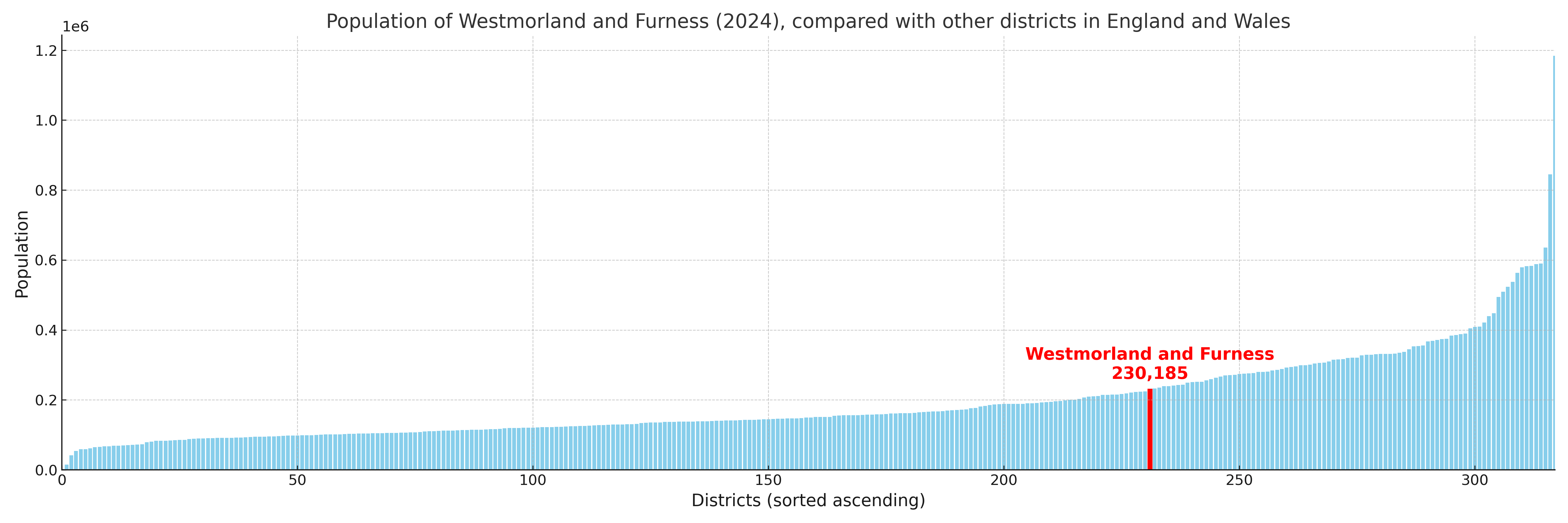Westmorland and Furness
§ This page gives an overview of the Westmorland and Furness local authority district, bringing together key facts, maps, and data to help you quickly understand the area. One of 361 district profiles on Baseview.
Overview ⁞ Westmorland and Furness covers a vast area of Cumbria, stretching from the Lake District mountains to the Cumbrian coastline. It includes some of England’s most dramatic landscapes, such as Windermere, Coniston Water, and Ullswater, surrounded by fells like Helvellyn and the Langdale Pikes. The Eden Valley offers rolling farmland, rivers, and market towns like Penrith, while the Furness Peninsula, with towns such as Barrow-in-Furness and Ulverston, is defined by its industrial heritage and coastal views across Morecambe Bay. Historic sites such as Kendal Castle, Furness Abbey, and Roman remains sit alongside picturesque villages, stone cottages, and scenic walking trails. The district blends mountain ranges, lakes, and coast, making it one of England’s most varied and scenic areas.
Westmorland and Furness Boundary Map
This map shows the official boundary of the Westmorland and Furness local authority district, based on the latest geographic data published by the Office for National Statistics (ONS). It provides a clear view of the district’s extent and helps you understand how the area fits within the wider regional and national landscape.
Contains OS data © Crown copyright and database right 2025. Source: Office for National Statistics licensed under the Open Government Licence v3.0.
The administrative boundary of Westmorland and Furness can also be viewed on OpenStreetMap: District Boundary of Westmorland and Furness.
Key Facts about Westmorland and Furness
What region are Westmorland and Furness in? Westmorland and Furness are in the North West of England, a region within the UK.
What county is Westmorland and Furness in? Westmorland and Furness is in the county of Cumbria.
Is Westmorland and Furness a city? No, Westmorland and Furness is not a city. (Note: the UK has 76 officially designated cities.)
Who governs Westmorland and Furness? The local government for this district is: Westmorland and Furness Council (Unitary Authority).
▶ Official website of Westmorland and Furness Council 🔗 westmorlandandfurness.gov.uk

Which police force covers Westmorland and Furness? Policing in Westmorland and Furness is provided by Cumbria Constabulary 🔗 cumbria.police.uk, which serves 2 local authority districts: Cumberland ⁞ Westmorland and Furness.
Westmorland and Furness in International Geographies
In the International Territorial Levels (ITLs) hierarchy, Westmorland and Furness is an ITLs Level 3 area:
- (ITL 1) North West
- (ITL 2) ⇒ Cumbria
- (ITL 3) ⇒⇒ Westmorland and Furness
The International Territorial Levels are used by OECD member countries for statistical purposes to classify administrative areas. We have this listable page for easy browsing of ITL names and codes: International Territorial Levels.
Constituencies in Westmorland and Furness
Westmorland and Furness is divided into 4 parliamentary constituencies, listed below in alphabetical order.
A constituency is a specific geographical area that elects one Member of Parliament (MP) to represent them in the House of Commons. The United Kingdom is divided into 650 parliamentary constituencies. We have this list page for easy browsing of all UK parliamentary constituencies: List of Constituencies.
Wards in Westmorland and Furness
Westmorland and Furness is divided into 33 wards, listed below in alphabetical order.
- Alston and Fellside
- Appleby and Brough
- Bowness and Lyth
- Burton and Holme
- Coniston and Hawkshead
- Dalton North
- Dalton South
- Eamont and Shap
- Eden and Lyvennet Vale
- Grange and Cartmel
- Greystoke and Ullswater
- Hawcoat and Newbarns
- Hesket and Lazonby
- High Furness
- Kendal Castle
- Kendal Highgate
- Kendal Nether
- Kendal South
- Kendal Strickland and Fell
- Kent Estuary
- Kirkby Stephen and Tebay
- Levens and Crooklands
- Low Furness
- Old Barrow and Hindpool
- Ormsgill and Parkside
- Penrith North
- Penrith South
- Risedale and Roosecote
- Sedbergh and Kirkby Lonsdale
- Ulverston
- Upper Kent
- Walney Island
- Windermere and Ambleside
In the UK, a ward is a subdivision of a local authority area, used mainly for electoral and statistical purposes. Defined by the ONS, wards represent the primary unit for local elections, each returning one or more councillors to the local council. Wards are also used as a key geography for presenting population and census data.
Parishes in Westmorland and Furness
Westmorland and Furness is fully parished: 155 civil parishes, listed A-Z below.
- Ainstable
- Aldingham
- Alston Moor
- Angerton
- Appleby-in-Westmorland
- Arnside
- Asby
- Askam and Ireleth
- Askham
- Bampton
- Barbon
- Barrow
- Barton and Pooley Bridge
- Beetham
- Blawith and Subberthwaite
- Bolton
- Brough
- Brough Sowerby
- Brougham
- Broughton East
- Broughton West
- Burton-in-Kendal
- Cartmel Fell
- Casterton
- Castle Sowerby
- Catterlen
- Claife
- Cliburn
- Clifton
- Colby
- Colton
- Coniston
- Crackenthorpe
- Crook
- Crosby Garrett
- Crosby Ravensworth
- Crosthwaite and Lyth
- Culgaith
- Dacre
- Dalton Town with Newton
- Dent
- Docker
- Dufton
- Dunnerdale-with-Seathwaite
- Egton with Newland
- Firbank
- Garsdale
- Glassonby
- Grange-over-Sands
- Grayrigg
- Great Salkeld
- Great Strickland
- Greystoke
- Hartley
- Haverthwaite
- Hawkshead
- Helbeck
- Helsington
- Hesket
- Heversham
- Hincaster
- Hoff
- Holme
- Hugill
- Hunsonby
- Hutton
- Hutton Roof
- Kaber
- Kendal
- Kentmere
- Killington
- King's Meaburn
- Kirkby Ireleth
- Kirkby Lonsdale
- Kirkby Stephen
- Kirkby Thore
- Kirkoswald
- Lakes
- Lambrigg
- Langwathby
- Lazonby
- Levens
- Lindal and Marton
- Lindale and Newton-in-Cartmel
- Little Strickland
- Long Marton
- Longsleddale
- Lower Allithwaite
- Lower Holker
- Lowick
- Lowther
- Lupton
- Mallerstang
- Mansergh
- Mansriggs
- Martindale
- Matterdale
- Melmerby
- Middleton
- Milburn
- Milnthorpe
- Morland
- Mungrisdale
- Murton
- Musgrave
- Nateby
- Natland
- Nether Staveley
- New Hutton
- Newbiggin
- Newby
- Old Hutton and Holmescales
- Ormside
- Orton
- Osmotherley
- Ousby
- Over Staveley
- Patterdale
- Pennington
- Penrith
- Preston Patrick
- Preston Richard
- Ravenstonedale
- Satterthwaite
- Sedbergh
- Sedgwick
- Selside and Fawcett Forest
- Shap
- Shap Rural
- Skelsmergh and Scalthwaiterigg
- Skelton
- Skelwith
- Sleagill
- Sockbridge and Tirril
- Soulby
- Stainmore
- Stainton
- Staveley-in-Cartmel
- Strickland Ketel
- Strickland Roger
- Tebay
- Temple Sowerby
- Threlkeld
- Torver
- Ulverston
- Underbarrow and Bradleyfield
- Urswick
- Waitby
- Warcop
- Wharton
- Whinfell
- Windermere and Bowness
- Winton
- Witherslack, Meathop and Ulpha
- Yanwath and Eamont Bridge
A civil parish is the lowest tier of local government in England, used for villages, small towns, and suburbs. They have their own local authority, either a parish council or a parish meeting, which provides local services like managing parks, allotments, and streetlights, and represents the community's views to larger councils.
Built-up Areas in Westmorland and Furness
Westmorland and Furness covers 65 built-up areas, listed below in alphabetical order.
- Allithwaite
- Alston
- Ambleside
- Appleby-in-Westmorland
- Arnside
- Askam in Furness
- Backbarrow
- Barrow-in-Furness
- Bolton (Eden)
- Bowness-on-Windermere
- Brough (Eden)
- Broughton in Furness
- Burneside
- Burton-in-Kendal
- Cartmel
- Casterton
- Cliburn
- Clifton (Eden)
- Coniston
- Culgaith
- Dalton-in-Furness
- Endmoor
- Finsthwaite
- Flookburgh
- Grange-over-Sands
- Grasmere
- Great Urswick
- Greystoke
- Hawkshead
- Heversham
- Hilton (Eden) *
- Holme (South Lakeland)
- Kendal
- Kirkby Lonsdale
- Kirkby Stephen
- Kirkby Thore
- Kirkby-in-Furness
- Langwathby
- Lazonby
- Levens
- Lindal in Furness
- Lindale
- Long Marton
- Mellguards
- Milnthorpe
- Natland
- Newton Rigg
- Oxenholme
- Penny Bridge and Greenodd
- Penrith
- Rampside
- Sedbergh
- Shap
- Silverdale *
- Skelton (Eden)
- Sockbridge
- Stainton (Eden)
- Staveley (South Lakeland)
- Storrs
- Storth and Sandside
- Summerlands
- Swarthmoor
- Temple Sowerby
- Ulverston
- Windermere
In the UK, a Built-up Area (BUA) is a continuous urban area of at least 20 hectares (0.2 km²), defined by the ONS as land where buildings are generally no more than 200 metres apart, such as towns, cities, or large villages. (Note: A BUA name marked with an asterisk (*) indicates that the area is situated partly in the district of Westmorland and Furness.)
Westmorland and Furness compared with other districts in the UK
This section shows how Westmorland and Furness compares with other local authority districts in the UK, using a variety of measures and rankings.
Westmorland and Furness has 33 electoral wards.

Westmorland and Furness has a population of 230,185 (2024 mid-year estimate by ONS)

More local statistics and data for Westmorland and Furness can be found on the ONS statistics for Westmorland and Furness.